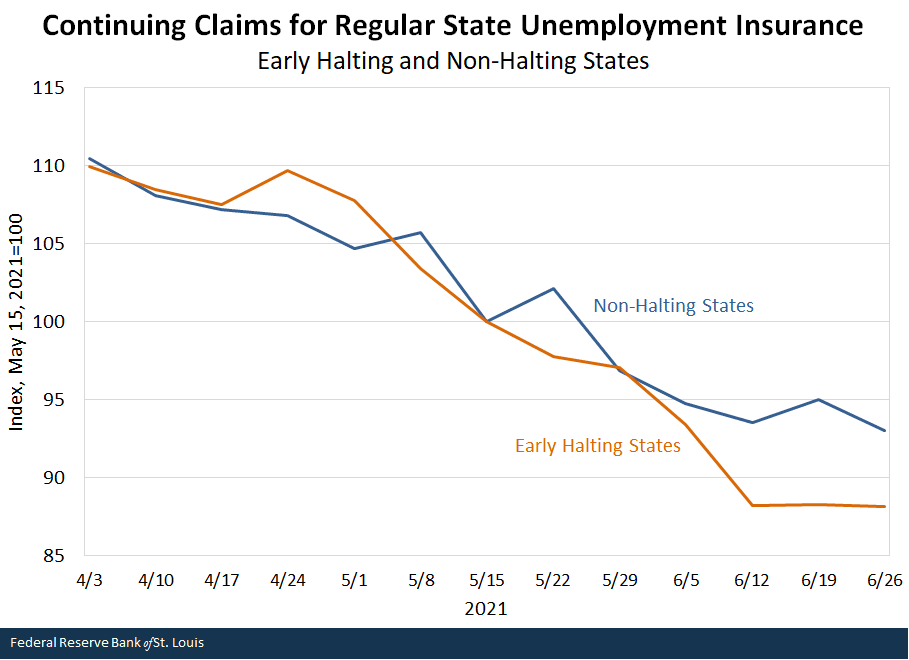Early Impact of States Halting Federal Jobless Benefits
Starting on June 12, several states have stopped accepting the federal government’s emergency unemployment insurance (UI) benefits, which were put in place in response to the pandemic. These benefits included a $300 weekly add-on for UI recipients, extended eligibility to unemployed people who otherwise would not be covered by their states’ programs, and a duration extension beyond those provided by regular state programs (RSPs).
Other states will be joining this group in the upcoming weeks, and this early termination will be in place in more than half of U.S. states by mid-July. A few of these states are no longer providing the $300 add-on but are continuing with other emergency benefits. The remaining states plan to maintain these emergency benefits until the federally mandated end of the program in September.
Importantly, all U.S. states will continue to operate their RSPs regardless of whether they halt the emergency benefits. While RSP details vary somewhat across states, a typical RSP offers benefits for up to 26 weeks and, up to some cut-off, a replacement rate of 40% to 50% of recent past wage income.
Halting and Non-Halting States
This policy difference across states generates an interesting question. What is happening to RSP participation in “halting” and “non-halting” states?
One possibility is that claimants on RSPs in halting states, recognizing that the $300 weekly add-on and duration extension have ended or will soon end, might drop out of the RSP for which they still qualify in light of the less-generous benefits. Those dropping out of RSPs in halting states might in turn be taking jobs and thus boosting employment levels in their respective states.
To explore this question, I considered two groups of states: (1) states that are continuing participation in emergency pandemic UI programs and thus continuing the generosity of those benefits, and (2) states that ended participation on or before June 19. I excluded states that will end participation after June 19. Though the RSP recipients in these states continue to receive the emergency benefits, these participants know that they’ll soon lose the federal benefits. Excluding these states provides for a more direct intergroup comparison. I call the former group the non-halters and the latter group the early halters.
Next, for each group, I summed the total continuing claims in RSPs by week. I took each resulting time series and transformed it into an index equal to 100 for (the week ending on) May 15. I chose May 15 because this is roughly the midpoint of the dates that the early halters announced their intention to terminate emergency benefits.
Continuing Claims in Early Halting States Have Declined More
As shown in the figure below, the blue and orange lines report the continuing claims indexes for non-halters and early halters, respectively.

SOURCES: U.S. Department of Labor and author’s calculations.
NOTES: Data are not seasonally adjusted. I excluded Alabama (an early halter) from the sample because it experienced an abnormally large (180%) increase in continuing claims in the final week of available data.
At the start of April, both series are roughly at 110 and, by construction, reach 100 on May 15. Thus, continuing claims for both groups fell by about 10% over the six-week period before the early halters announced their termination plans. There is no difference between the two groups before May 15, at least with respect to RSP continuing claims.
For both groups, the fall in continuing claims likely reflects the improved labor market, together with some claimants losing regular state benefits because they reached the maximum number of weeks afforded by their state programs.
After May 15, and particularly for the last three weeks of available data, there is a substantial separation in the two series. Relative to May 15, non-halting states’ claims have fallen by 7% whereas early halters’ claims have fallen by 12%. This difference has been persistent over the past three weeks for which the data are available.
Time will tell whether this difference persists, as new weekly data arrive and additional states implement plans to cease providing emergency benefits. Upcoming employment reports will tell whether the difference in RSP continuing claims is also associated with a difference in employment growth across the two groups.
Notes and References
- A few of these states are no longer providing the $300 add-on but are continuing with other emergency benefits.
- I excluded states that will end participation after June 19. Though the RSP recipients in these states continue to receive the emergency benefits, these participants know that they’ll soon lose the federal benefits. Excluding these states provides for a more direct intergroup comparison.
Additional Resources
- On the Economy: A Tale of Two Business Cycles during the Pandemic
- On the Economy: How Job Separations Differed between the Great Recession and COVID-19 Recession
Citation
Bill Dupor, ldquoEarly Impact of States Halting Federal Jobless Benefits,rdquo St. Louis Fed On the Economy, July 13, 2021.
This blog offers commentary, analysis and data from our economists and experts. Views expressed are not necessarily those of the St. Louis Fed or Federal Reserve System.
Email Us
All other blog-related questions


